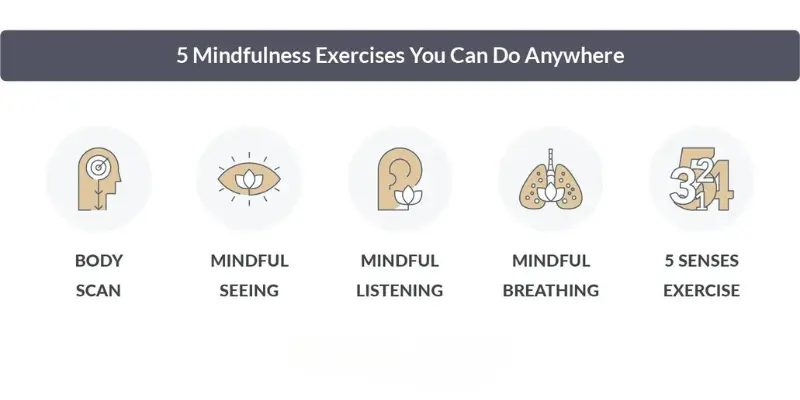Yes, we are in a busy environment and taking a break may not be the first thing we do when we are stressed. Help has arrived. This blogpost clearly enumerates 5 mindfulness exercises that can assist you in sustaining calmness.
Introduction
For many, mindfulness is a technique that involves focusing on the present moment. It is an effective exercise that involves bringing your attention to every sensation. Thus, it makes you present in the moment. You control your mind when you practice mindfulness.
This blog post has painstakingly carved out 5 simple mindfulness exercises that you can incorporate in your routine. You should do this to cultivate mindfulness as it will calm your mind.
5 Mindfulness Exercises Worth Trying

The exercises we will be deliberating on include the following:
- Mindful breathing (how to take a deep breath)
- Mindful walking
- Mindful eating
- Grounding exercise
- Everyday mindfulness – how to practice it
What are the benefits of mindfulness?
The benefits of mindfulness have been carefully considered by researchers. Find below some mind-blowing ones.
- Enhancement of your cognition, concentration and focus.
- Enhancement of your brain health and overall quality of life
- It is a helpful tool to manage stress, anxiety and depression.
- It is a successful pain management technique.
1. Take a Breath

This is very simple – it is something you can try anywhere. You could sit or stand. But wait a minute. Let us show you how it is done so you can do it right.
How to do it
- Inhale and exhale slowly for about 6-8 seconds.
- Breathe in through your nose. Breathe out same way too. This will make you calm and enhance breath flow.
- Simply let your thoughts rise and fall without reacting to them.
- Focus on your sense of awareness and watch as it works its way up and out your nose as it returns to the world. Even if your mind wander, do not get discouraged. Gently guide your attention back to staying in the present.
Read Also” Unlock Inner Peace with These 12 Types of Meditation Techniques
Benefits: reduces stress, improves focus
Practicing mindful breathing exercise helps to calm the nerves. When this happens, your stress levels are lowered. It also helps to improve focus and helps you attain higher states of consciousness. It also helps to relieve pain, lower blood pressure and decrease inflammation.
Try this for 5 minutes per day
Begin with just 5 minutes each day. Gradually increase your time as you find the exercise more enjoyable. If you still feel it is too long, you can reduce it to 2 minutes. Do this multiple times each day and set a consistent schedule to it.
2. Walking Meditation
Walking meditation is one great mindfulness practice that you can add to your daily practice. It will help spice it up – whether you are doing it in the morning, afternoon, or evening.
How to do it mindfully
- As you take a walk, focus on your breath. Practice deep breaths.
- Pay attention to your posture. Keep your head straight. Stand upright and keep your shoulders relaxed.
- Pay close attention to your feet. Notice as you place your heel on the ground. Then, notice how the ball of your foot touches the ground before you lift it. Pay the same attention to the other foot.
- Try to notice what is around you. Colors such as blue sky or the colors of flowers and grass. Notice nature as well such as trees or wind.
- Pay attention to your sense of hearing – such as people talking, the singing of birds or the sound of a vehicle.
- Pay attention to your sense of smell – maybe a well cooked meal or the smell of a freshly cut grass.
Improves awareness and appreciation of surroundings
Practicing mindful walking helps you connect with your body. It can improve appreciation of your environment. It is also reported that it can improve mood. It strengthens your willpower or mental fortitude to do something. If you are a sedentary person who walks little, trying mindful walking can boost your energy by as much as 65 percent.
Try this for 10 minutes when walking
A simple mindfulness exercise like walking for just 10 minutes can reset your day and bring back your feelings to calmness. Try walking in a quiet street, not a busy one. At the end of the walk, show gratitude for the time and opportunity. This can help you get back to the present moment with the boosted energy.
3. Grounding Exercise (Feet on the Ground)
Grounding exercises are techniques that helps you become aware of the present moment, in body sensation especially if you are tensed or upset. It can help you pull away from negative thoughts and feelings. It helps you refocus and align your mind while you overcome distractions. Grounding exercises can be done physically or mentally.
You can perform this practice of mindfulness in various ways. These include walking barefoot or lying on the ground.
Steps on How to ground yourself in the present moment
If you are lying or sitting on the ground, then you can try this:
- Sit up straight and keep your feet on the ground. You could decide to close your eyes – or not.
- Next, direct your attention to your left foot. Take note of how it makes contact with your shoe, sock or the bare ground.
- Try to feel the different parts of your foot – the toes, the heel, etc. You can even wiggle them. Can you feel the flow of blood in that region? What is the temperature of the foot – is it cold or warm? If you feel anything, single it out.
- If at this point you notice you are getting distracted, no worries. Try to bring your attention back to your left foot.
- Now, focus on the right foot. Take note of how it makes contact with your shoe, sock or the bare ground.
- Endeavor to feel different parts of the foot as you did with the left one. Wiggle this one as well and see if you can feel any sensations.
- Focus on both feet at the same time.
- Feel the sensation of your feet. Imagine yourself being strong and stable.
- Release attention from your feet and pay attention to sounds around you.
Helps shift focus away from worries
Grounding exercises help to reconnect you with the earth and nature at large. It channels your focus to something more soothing. It makes you less worried of things you have no control over. Physical benefits of this exercise include improving blood flow and heart rate. It strengthens one’s immune system. It improves wound healing and physical energy.
It has also been reported that grounding exercises have spiritual benefits. This includes bringing feelings of peace and contentment after the exercise. It helps one return to a simpler way of life that is reorganized and productive.
Do this for 2 minutes whenever feeling anxious
Within a minute or two, you can successfully ground yourself. It doesn’t take so much.
- The popular 5-4-3-2-1 method: In case this method is new to you, relax. We will explain it. Here, you have to focus on 5 things you can see. Another is to focus on 4 things you can feel. The next is to contemplate on 3 things you can hear. Also, you have to focus on 2 things you can smell and lastly, on 1 thing you can taste. Those who have done this attest to the fact it reduces anxiety.
- Do more of nature walks
- Never underestimate the effectiveness of visualization and positive affirmations.
- Practice gratitude after performing the exercise. This will motivate you to do be regular, consistent and thorough.
4. Mindful Eating
Eating is an enjoyable experience, not so? How was it like the last time you swallowed your desired meal? No doubt, it was a bliss. But do you know that eating mindfully can make you have a more enjoyable and richer experience? This is a great exercise to satisfy your nutritional needs.
How to eat slowly and mindfully
- Avoid distractions such as watching the television, reading the newspaper, listening to the radio, operating your mobile phone and talking. Just sit down and eat.
- Take a moment to pause and breathe before eating. Doing this will allow us to slow down and calmly transit to our meals.
- The next thing is to close your eyes. This will help bring your awareness to the present. Take deep, belly breaths before you have your meal.
- Focus your attention on your physical body. How hungry are you? Do you feel any physical sensations in your belly? Physical sensations such as an empty stomach, shakiness, lack of appetite, etc. can really tell how much we will enjoy our meal.
- Choose good food. Strive to eat at the right time and with the right amount.
- Mindful eating should continue even in your next meal. Remember, you cannot savor or digest a meal when you are not relaxed.
- As you experience the taste, flavor and texture of a meal, do not force yourself to eat something you do not love. You can leave it and prepare something better.
Increases gratitude and enjoyment of food
The benefits of mindful eating are endless. It helps improve digestion. It increases your satisfaction and enjoyment of food. Since taking your time to enjoy your food makes you fuller quickly, there is a less chance you will overeat. It promote nutrient absorption and a healthy food choice.
Try this at your next meal
The next time you are about to dig into your delicious meal, try clearing the area of distractions including mobile phone. Take deep breaths before you eat. Feel the texture, flavor and taste. Think about the color of the meal and how it resonates with your being. Make sure you properly chew your each mouthful.
5. Everyday Mindfulness
This involves bringing our full attention to one thing as often as possible as we engage in everyday activities. Some opportunities to practice mindfulness include noticing nature, showering, driving, washing dishes, and self-compassion.
Tips for being mindful throughout your day
- Before you start your day, take a few conscious breaths. Smile before you get out of the bed.
- Do not be stuck in one place. Move more throughout the day.
- As you work during the day, pay attention to your communication patterns and sensations in your body.
- Take occasional breaks and practice nonjudgmental observation of yourself.
- Practice visualization by means of your five senses.
- At the end of the day, create an unwinding routine.
- You can track your mindfulness with the aid of apps.
Boosts focus, reduces stress, improves productivity
Practicing mindfulness helps you release the stream of thoughts that may be crowding your mind. This improves focus and productivity. It also improves mental health and lowers stress levels. It enables you get easy control of your emotions. It improves cognition and makes you feel more connected to yourself and to others.
Integrate mindfulness into daily activities
You can still practice mindfulness no matter how busy you think you are. Just focus on the rhythm of your breath. You can use mindfulness apps to serve as a daily reminder in order to make you regular and consistent. You can also have a meditation group. Practice active listening and focus on your senses as you live each day. When you start with these, you will realize how easy it can be.
Mindfulness Techniques for Depression and Anxiety
Here are some mindfulness techniques that have proven to be effective and beneficial:
- Meditation Practice: This helps an individual to find peace with himself and connect with his thoughts. It helps one recover from anxiety and reduce depression.
- Morning Pages Journaling: Waking up early in the morning to write is a powerful technique that helps an individual to keep track of his life. It helps him figure out his stream of problems and then allows him to leave them aside as he continues his day.
- Recognition and Realization: These techniques involve being aware that there is a problem, allowing us to acknowledge whatever is wrong without passing judgment and taking the right step to solve it.
- Attention Training: This involves having a list of tasks and designating enough time to complete one task at a time. It reduces negative feelings as there is no multitasking.
- Body scan meditation: With this technique, an individual is able to focus more on himself and on positive thoughts. This will help him cultivate acceptance and gratitude.
Read Also: Why do People Struggle with Meditation?
10 mindfulness activities to enrich your life
- Mindful counting
- Mindful eating
- Mindful movement of your body
- Mindful driving
- Mindful breathing
- Mindful walking
- Body scan meditation
- Practice single-tasking
- Develop the art of gratitude
- Develop the art of mindful listening.
Conclusion
You have read a lot and must have been satisfied. It’s time to wrap this up. Here are the 5 mindfulness exercises: The first is deep breath, the next is walking meditation. Then we have grounding exercises. Another one is mindful eating and lastly everyday mindfulness.
Why not endeavor to start caring for your emotional health now? Mindfulness can help you do that.
As we have already revealed, a wide range of mindfulness teaches you to be focused. It can calm your nerves and promote good health. It can also sharpen your cognitive skill and concentration – attributes that you will need both at work and in everyday life. Try incorporating mindfulness as soon as possible and you will be thankful.
FAQ’s:
Q. Are there 5 steps of mindfulness? If yes, what are they?
Yes, there are. (a) Mindful walking (b) mindful breathing (c) concentration (d) releasing tension and € body awareness.
Q. Is it possible for me to be mindful with ADHD?
A. Yes, you can try a few things such as journaling and mindfulness meditation.
Q. How can I practice mindfulness in 3 ways?
A. Mindful eating, mindful listening and mindful speaking.
Q. Can meditation and mindfulness help?
A. It can help reduce stress and anxiety alongside other negative emotions. It is a good exercise for the brain, sharpening focus, cognition and concentration.
Q. Why should I practice short mindfulness exercises?
A. Short mindfulness exercises for beginners can help one maintain consistency and regularity. It will also prevent one from becoming bored or distracted. As you progress, you may want to extend the period of mindfulness.

